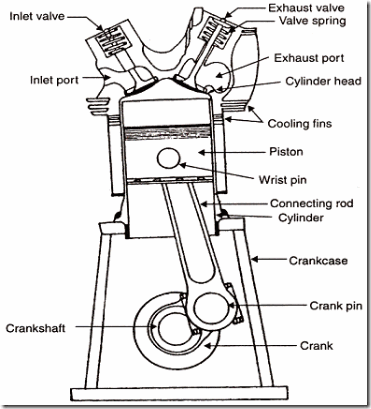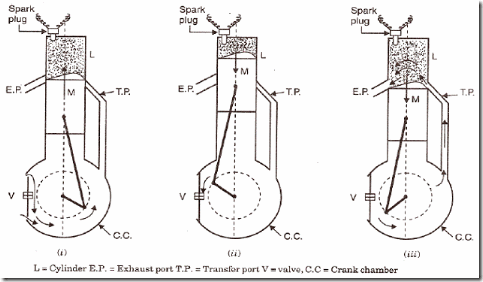Objective: To study about 2 stroke engine.
Introduction
Heat Engines: Any type of engine or machine which derives heat energy from the combustion of fuel or any other source and converts this energy into mechanical work is termed as a heat engine.
Classification of Heat Engines
- · External Combustion Engines
- · Internal Combustion Engines
External Combustion Engines: In this case, combustion of fuel takes place outside the cylinder as in case of steam engines where the heat of combustion is employed to generate steam which is used to move a piston in a cylinder. Other examples of external combustion engines are hot air engines, steam turbine and closed cycle gas turbine. These engines are generally used for driving locomotives, ships, generation of electric power etc.
Internal Combustion Engines (I.C. Engines): In this case, combustion of the fuel with oxygen of the air occurs within the cylinder of the engine. The internal combustion engines group includes engines employing mixtures of combustible gases and air, known as gas engines, those using lighter liquid fuel or spirit known as petrol engines and those using heavier liquid fuels, known as oil compression ignition or diesel engines.
Classification of I.C. Engines:
Internal combustion engines may be classified as given below:
1. According to cycle of operation:
- Two-stroke cycle engines
- Four-stroke cycle engines
2. According to cycle of combustion:
- Otto cycle engine
- Diesel cycle engine
- Dual-combustion
3. According to the fuel employed and the method of fuel supply to the engine cylinder:
- Petrol engine
- Diesel engine
- Oil, Gas engine
4. According to method of ignition:
- · Spark ignition (S.L) engine
- · Compression ignition (C.I.) engine
5. According to method of cooling the cylinder:
- Air-cooled engine
- Water-cooled engine
6. According to number of cylinders:
- Single cylinder engine
- Multi-cylinder engine
Different Parts of I.C. Engines (Parts Common to both Petrol and Diesel Engine):
1. Cylinder
2. Cylinder head
3. Piston
4. Piston rings
5. Gudgeon pin
6. Connecting rod
7. Crankshaft
8. Crank
9. Engine bearing
10. Crank case
11. Flywheel
12. Governor
13. Valves and valve operating mechanism
Parts for Petrol Engines Only:
1. Spark plugs
2. Carburetor
3. Fuel pump
Parts for Diesel Engine Only:
1. Fuel pump
2. Injector
Fig. Air Cooled I.C Engine
TWO-STROKE CYCLE ENGINES
- Two Stroke Petrol engine
- Two Stroke Diesel engine
TWO STROKE ENGINES
In 1878, a British engineer introduced a cycle which could be completed in two strokes of piston rather than four strokes as is the case with the four-stroke cycle engines.
In this engine suction and exhaust strokes are eliminated. Here instead of valves, ports are used. The exhaust gases are driven out from engine cylinder by the fresh charge of fuel entering the cylinder nearly at the end of the working stroke.
A two-stroke petrol engine (used in scooters, motor cycles etc.).
The cylinder L is connected to a closed crank chamber C.C. During the upward stroke of the piston M, the gases in L are compressed and at the same time fresh air and fuel (petrol) mixture enters the crank chamber through the valve V.
When the piston moves downwards, V closes and the mixture in the crank chamber is compressed the piston is moving upwards and is compressing an explosive change which has previously been supplied to L. Ignition takes place at the end of the stroke. The piston then travels downwards due to expansion of the gases and near the end of this stroke the piston uncovers the exhaust port (E.P.) and the burnt exhaust gases escape through this port.
The transfer port (T.P.) then is uncovered immediately, and the compressed charge from the crank chamber flows into the cylinder and is deflected upwards by the hump provided on the head of the piston.
It may be noted that the incoming air-petrol mixture helps the removal of gases from the engine-cylinder; if, in case these exhaust gases do not leave the cylinder, the fresh charge gets diluted and efficiency of the engine will decrease.
The piston then again starts moving from B.D.C. to T.D.C. and the charge gets compressed when E.P. (exhaust port) and T.P. are covered by the piston; thus the cycle is repeated.
Prepared by:
Mr. Sachin Chaturvedi,
Lecturer, Department of Mechanical Engineering,
Brown Hills College of Engineering and Technology,


22 Responses to “LAb Manual | To study about 2 stroke engine.”
R.Saravanan
Your informations are very usefull for me. If possible send your updates to my mail id.
Varun Pratap
plz i need one copy of it.
thanks
prabhakaran
very
GARVISH KAPADIA
A good material. If possible please e-mail me your all updates. Thanks.
admin
Thanks for the appreciation. You can follow us on facebook to get all the updates.
vinod kumar
A good material. If possible please e-mail me your all updates. Thanks. i need all copy of manual of thermodynamics lab acc to uptu
kamal kapoor
thanks thats realy nice material to help me by which i clear the doubt
jojo alex
GOOD informative,,,simple in langusge,,,helped me a lot,,,
jashan
very easy method i have one new method for working of two stroke engine
naresh kumar
good to know this in an easy way sir but i hope u can even classify and xplain the 2 stroke into both petrol and diesel engines
narmada
nice documents……… i got that i needed….. thanku…….. great job , KEEP IT UP.
narmada
DID U GOT WHAT U NEEDED…..@naresh kumar
Amit Kopardekar
such a very good helpful material, i requested to sir please send information about
1) study of Pumps and compressor
2)Estimation of Velocity Ratio / Gear Ratio of a Given Mechanical Transmission System.
mahnoor
nice documents indeed …!!!!!
mahnoor
nice documents indeed …!!!!!
i want a suggestion as soon as possible is industrial and manufacturing btr fron enviromantal engg???
Obdulia
Also it helps if you do it soon after a shower.
Industrial Engineering Lab Manual
[…] PDF File Name: Lab manual | to study about 2 stroke engine. – engineering Source: engineering.myindialist.com » DOWNLOAD « […]
Anyewi George
very usuful information, could i have a copy in my mail?
Anyewi George
very useful information, could i have a copy in my mail?
r.m. katkar.
very useful information.
Demai
ya good thing I want more updates
u4fifa
look great today.